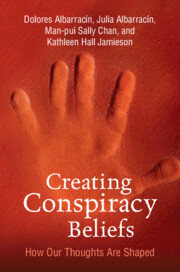Book contents
- Creating Conspiracy Beliefs
- Creating Conspiracy Beliefs
- Copyright page
- Dedication
- Contents
- Figures
- Tables
- Preface
- Acknowledgments
- Chapter 1 Introduction
- Chapter 2 A Framework for Understanding How Conspiracy Beliefs Are Created
- Chapter 3 The Consequences of Conspiracy Beliefs
- Chapter 4 Anxiety, Psychological Motivations, and Conspiracy Beliefs
- Chapter 5 Sociopolitical Factors and Conspiracy Beliefs
- Chapter 6 The Relation between Media and Anxiety
- Chapter 7 The Influence of Norms and Social Networks on Conspiracy Beliefs
- Chapter 8 Influences of Media and Anxiety in a Psychological and Sociopolitical Context
- Chapter 9 Conclusions
- Appendix Methodology of Our Studies and Samples
- References
- Index
- References
References
Published online by Cambridge University Press: 18 November 2021
- Creating Conspiracy Beliefs
- Creating Conspiracy Beliefs
- Copyright page
- Dedication
- Contents
- Figures
- Tables
- Preface
- Acknowledgments
- Chapter 1 Introduction
- Chapter 2 A Framework for Understanding How Conspiracy Beliefs Are Created
- Chapter 3 The Consequences of Conspiracy Beliefs
- Chapter 4 Anxiety, Psychological Motivations, and Conspiracy Beliefs
- Chapter 5 Sociopolitical Factors and Conspiracy Beliefs
- Chapter 6 The Relation between Media and Anxiety
- Chapter 7 The Influence of Norms and Social Networks on Conspiracy Beliefs
- Chapter 8 Influences of Media and Anxiety in a Psychological and Sociopolitical Context
- Chapter 9 Conclusions
- Appendix Methodology of Our Studies and Samples
- References
- Index
- References
Summary

- Type
- Chapter
- Information
- Creating Conspiracy BeliefsHow Our Thoughts Are Shaped, pp. 257 - 303Publisher: Cambridge University PressPrint publication year: 2021

